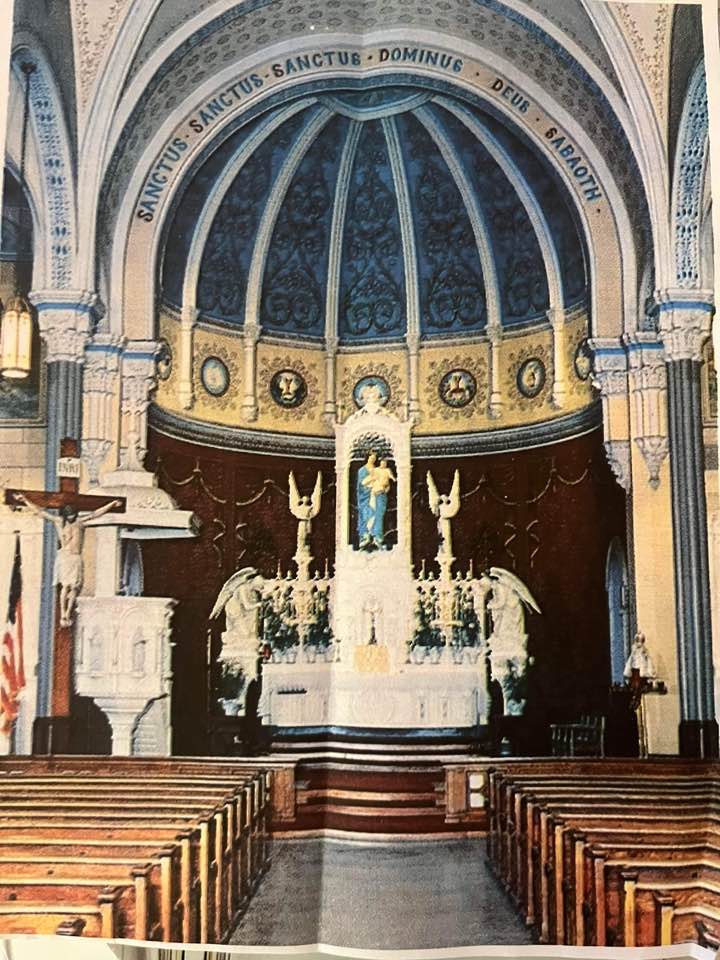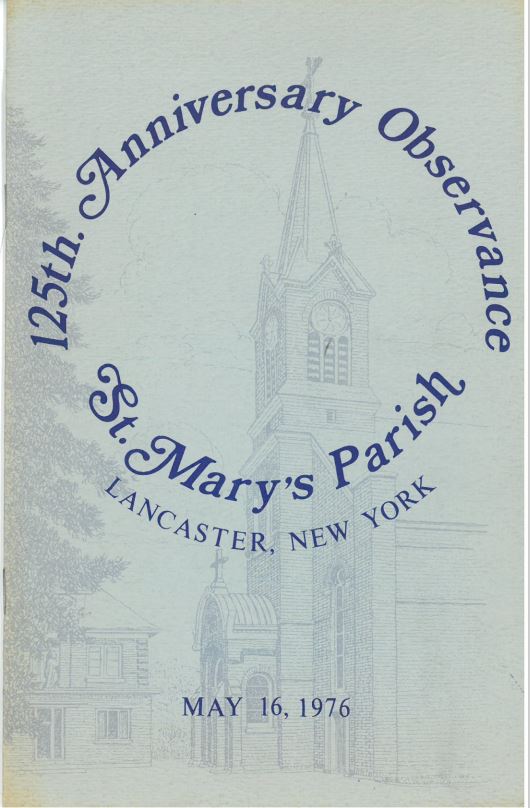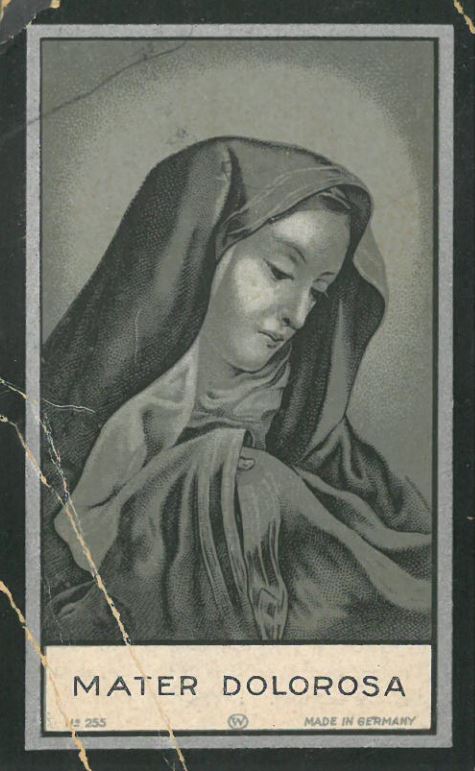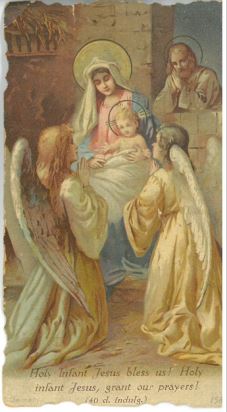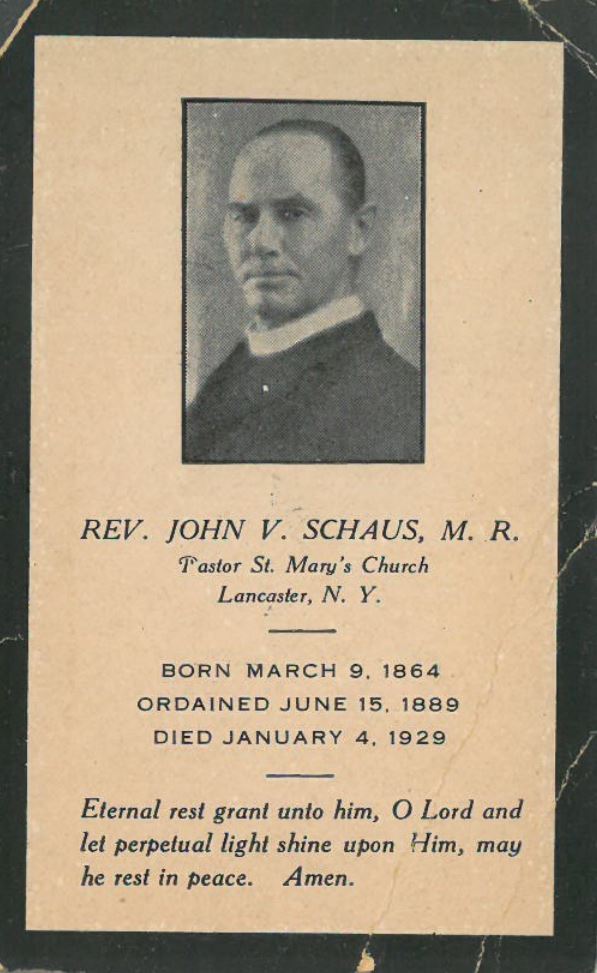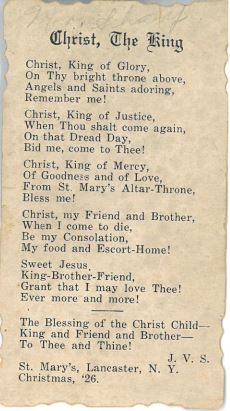Our History
St Mary of the Assumption, Est. 1850
In history, as in the natural world, all things are connected. Seemingly remote events often prove to be necessary antecedents of later stories. Chief Red Jacket’s meeting in Geneseo with the Phelps & Gorham Land Co. is one beginning for our story. That meeting between the Indians and the New England Company concluded the sale of land and the migration of the Senecas that allowed for the settlement by European peoples throughout Western New York. Robert Morris, the Revolutionary financier, bought the land area that now embraces Erie and parts of Genesee and Wyoming counties. He, in turn, resold this purchase to the Holland Land Co. on July 20, 1793. A skillful surveyor, Joseph Ellicott, mapped out this new territory. Within a decade, the land was surveyed, county and townships were laid out, and roads were built. Land was then sold at attractive prices to attract settlers from the East, who were looking to expand the horizons of their new nation.
The settlement, now know as Lancaster, gradually appeared. At first known as “Cayuga Creek”, the first settlers came in 1803. By 1808, stores, grist and lumber mills were in operation. Ahaz Luce opened the first general store in 1810. Luce is important to our parish story because he was the original owner of the land that we now known as St. Mary’s Hill. In these early days of settlement, New Englanders came first. Records show no Catholics among them. Catholicism was not tolerated in New York State in colonial times. As late as 1784, there was not a single Catholic congregation in New York State.
In time, immigrants came from Germany, principally from Alsace and Bavaria. These people were the first Catholic settlers in Lancaster. They arrived throughout the 1820’s and 1830’s. By 1834, records of fifteen Catholic families in Lancaster are extant. These families received pastoral guidance and ministry from Rev. Nicholas Mertz, the founder of St. Louis church in Buffalo. These families walked eleven miles to church on Sunday. Fr. Mertz realized that the two dozen children of these Lancaster settlers needed regular religious instruction if they were to follow their parents’ faith commitment. He arranged a sort of traveling catechetical school in the winter months, when the children were freed from their annual field labors. Under Fr. Mertz’s direction, and with amazing foresight, these German families pooled their resources to purchase the land now occupied by St. Mary’s Parish. On January 6, 1834, the purchase was concluded with the dream of one day building a church and a school. The deed records the land purchase at 4:00 PM on January 6, 1834 for the amount of $80.00 between Truman and Lauretta Luce and Sebastian Stockle, representing the Catholic Society of the town of Lancaster, German immigrants tended to envision their new settlement like those in their homelands. So they chose for their worship areas hilly lands usually situated at the end of their village. St. Mary’s Hill looked very different than it appears now. It was almost inaccessible since a dense forest covered it. A brook meandered through what is now our cemetery.
Thus it began. The faith of the few and a forested hill were to become the seeds for the faith development of thousands. Every great enterprise has its roots in its founders’ hopes. St. Mary’s is no exception. The names were Ott, Meyer, Block, Uebelhoer, Fuchs, Gleiss, Zimmer, Wohl, Merge, Voegele. On their shoulders we stand. They in turn, stood upon others’ sacrifices. All of us remain dependent upon God who began this amazing story of love, and who will see it through to its completion.
Fr. John Neumann, declared a saint by the Church in 1977, came from Bohemia. His feast day is celebrated on January 5. He was a visiting priest to St. Mary’s between 1837-1840. Neumann was instrumental in bringing about the erection of the first church on St. Mary’s Hill. He celebrated Mass there once a month. He also established St. Mary’s first school. It was constructed at the crossroads of Transit and Broadway. Thirty pupils were registered. Mr. Schwam was its first schoolmaster. Fr. Neumann joined the Redemptorist order in 1840, and so left our area. He later became Bishop of Philadelphia.
The first priest to actually live in Lancaster was Fr. Noethen. He lodged with a local Catholic family and celebrated Mass daily in the small log church-on-the-hill. In 1842, he saw to it that the school was moved to St. Mary’s Hill. It was a three-room building, one room was the school, and the remaining two rooms were the priest’s residence. Mr. Michael Smith was the only teacher, a position he held for seven years.
At mid-century the problem of trusteeism arose. Given the fact that Catholics in America came from nations with diverse cultures, there were different customs regulating the relations between laity and clerics. In some countries, the state supported the church, as in Germany to this day. In some countries the people elected their pastors. In some lands, church property was owned by the local community. Everyone assumed their tradition of operating would be functional in America. With few dioceses formed, Catholics were pretty much left on their own arrangements. Trustees of Catholic parishes, having operated creatively without ecclesiastical authorities, often thought that they could dictate policies regarding pastoral appointments and financial arrangements. Consequences of this situation were disputes over debts, pastoral appointments, and even the content of preaching.
Rome decided that in the best interests of all that the Ordinary Bishop of each diocese should hold church properties, and that he be supported by a board of trustees, composed of two lay members of the parish, the pastor, whom only the Bishop could appoint, and the vicar-General of the diocese. Not everyone agreed with this arrangement. Resistance was met by Bishops with the closing, and sometimes interdicting, of parishes. Our first Buffalo parish, St. Louis, was twice placed under interdict because of trustee disputes. Interdiction is a form of censure that forbids that a local church carry out its sacramental, liturgical, and ministerial mandates. In effect, it closes the church.
St. Mary’s was touched by these concerns. Thus, for a time, St. Mary’s was without a priest. During this time, probably between 1845-47, the people continued devotional, para liturgical practices. However, records show that a few parishioners set up an alternate church in a small one-story house on what today is St. John’s St. They marked it with a red cross. Whether any eventual reconciliation was achieved is not discernable from available documents.
On April 23, 1847, Pope Pius IX established the Diocese of Buffalo and appointed John Timon as its first Bishop. Bishop Timon visited St. Mary’s, Lancaster, during the autumn of 1847 and administered the sacrament of Confirmation. Bishop Timon recorded that the church sat only about two hundred people, and that it was too small for those in attendance. On November 25, 1847, the trustees deeded over to the Bishop the church, school, and property they had purchased. The trustee’s names were Joseph Sugg, Jacob Jerge, George Krimm, George Ott, and Joseph Zimmet. Bishop Timon, in turn, asked the Redemptorist priests of St. Mary’s, Buffalo, to care for the parish. A priest came every other week, a twelve-mile journey, to celebrate Mass and baptize. The journey was made on foot from Pine St. and Broadway to St. Mary’s Hill. Our parish sacramental records date from November of 1847.
The families who were the formative pioneers of the parish that was incorporated on St. Mary’s Hill bore the following names: Meyers, Stockl, Bund, Schwartz, Raynor, Huber, Ott, Jerge, Smith, Kaiser, Eismann, Weisbeck, Ringeisen, Lambrix, Messner, Forness, Landin, Laux, Naab, Kircholder, Suttel, Grant, Merge, Zimet, Zugg, Beyer, and Nuwer.
Many priests were assigned to serve St. Mary’s, Lancaster between 1850-2000. On July 28, 1850, Bishop Timon sent a resident pastor, who, by birth, was a Russian nobleman. His name was Fr. Sergius de Stchoulepnkoff. He supervised the building of the first brick church on our hill. The dedication of that church, under the corporate title “St. Mary’s Church of the Assumption” of Lancaster, N.Y. led to the official recognition of St. Mary’s as a diocesan parish. Papers of the day note that the parishioners right in Lancaster at a local brickyard made the bricks for the church.
The second pastor, Fr. Urich, built an orphanage for boys. A cholera plaque had swept the country and left many orphans. Three laywomen, all sisters, were in charge of about sixty boys. It was called “St. John’s Protectory for Orphan and Wayward Boys.” It remained on St. Mary’s Hill for about twenty years and then was moved to Lackawanna and became in time known as Fr. Baker’s.
Other pastors followed. Fr. Nicholas Sester, Fr. Klein, Fr. Sawistowski came between 1856 and 1863. On January 3, 1863, in the middle of the American Civil War, Fr. Henry Feldman came as pastor. He led the construction of the first rectory. Pastors lived there until 1908. Subsequently, it became the home to Mr. Leo Roy, the church organist. Fr. Feldman also oversaw the building of a brick school to replace the previous wooden structure. The southern slope of our hill was used a farm, where corn, potatoes, and cabbage were grown.
Fr. Sester, who had two separate terms as St. Mary’s pastor (1856-59, 1867-91) was born in Alsace. He purchased the land west of the church and rectory. He, also, is credited with “leveling the hills and filling up the valleys” of St. Mary’s property. Records tell of the toil and labor of parishioners to terrace the hill, root-up stumps, bring in topsoil, sow grass, and plant shrubs and saplings. Fr. Sester, in 1874, built a new school on the site of the old orphanage. The old school had become over crowded.
Prior to 1874, the school was directed by a series of male schoolmasters. In 1874, the Miss Nardins took over the school. They taught the girls and the younger boys. Male schoolmasters in the old school taught older boys. Miss Agnes Boetsch was the first directress. Miss Mary Zech, who remained in charge for twenty-two years, followed her. The Miss Nardins left in 1896.
By 1889, the old brick church built in 1850 would no longer accommodate the parishioners. Plans were made to enlarge it, and it was dedicated in 1890. This is the very building we inherit to this day.
Fr. Sester was a musician, a proficient organist. He held many sacred concerts in the church. He personally chose the bells that still ring from the church. Three parishioners, Mrs. Peter Marky, Mr. John Nuwer, and Mrs. Kolb, paid for their purchase. The bells were named Mary, Joseph, and John.
A Fr. Andrew Frey succeeded Fr. Sester for a short time. In 1892, Fr. Vincent Sheffels arrived as pastor. He oversaw the construction of an auditorium, which became the parish social center. He also arranged for the Sisters of the Third Order of St. Francis to direct our parish school. On September 6, 1898, Sr. Mary Antoinette arrived with five other sisters. To this day, the Williamsville Franciscans have maintained a dedicated ministry to our parish. Under the sisters’ guidance, the school grew until at one time there were over eight hundred students and nineteen sisters on the teaching staff.
The phenomenon of many vocations to the presbyterate and to religious life from St. Mary’s coincides with the turn of the century and with the presence of the Franciscan sisters. These became the decades of church societies of all kinds. The pastor who arrived in 1900 and stayed here until his death in 1929, Fr. John Schaus, particularly promoted these.
In 1903, the plans for a new school were revealed to parishioners. In 1904, a regular high school curriculum was added to the school. In the same year, Regents examinations were held for the first time. The first parochial high school in the United States was inaugurated and was officially chartered under the Regents of the State of New York in 1912. In 1913, an addition to the school doubled its capacity.
In 1908, a new and present rectory was built. In August of that same year, Mr. Leo Roy came as the church organist. Publicity of the times lauds Mr. Roy’s dedication and commitment to all aspects of liturgical and sacred music. He is credited with the formation of an outstanding choir.
St. Mary’s began to acquire what we now call parochial vicars, then referred to as assistant pastors, from 1890 onward. Many “parochial vicars” spent time at St. Mary’s during the pastorate of Fr. Schaus. Below are those acknowledged by the parish and/or diocesan records:
- (1901-1902) Fr. Michael Weber – went on to St. Louis Church, Buffalo
- (1902-1905) Fr. Augustine Fricker – became pastor of St. John the Evangelist, Buffalo
- (1905-1909) Fr. Aloysius Faessler – became pastor of Good Shepherd, Pendleton
- (1909-1914) Fr. Max Mueller – became pastor of St. Nicholas, N. Java
- (1914-1918) Fr. Frank Hoernschemeyer – he died in the epidemic of 1918 and is buried in our cemetery
- (1918-1925) Fr. Leo Hoen – became director of vocations for the Diocese of Buffalo
- (1920-1924) Fr. Thomas McGuire – became pastor of St. Joseph’s, LeRoy
- (1924-1929) Fr. Martin Ebner – became pastor of Fourteen Holy Helpers, Gardenville
- (1925-1929) Fr. Louis Witkop
Fr. Schaus died on January 4, 1929. In February, he was succeeded by Fr. John Schmitt. It was during this pastorate that the exterior of the church received its present-day brick veneer, the sanctuary was enlarged, new maple floors were laid beneath the pews, and in the spring of 1936, the present stained glass windows were imported from Innsbruck, Austria. The parish cemetery was also enlarged, along with the rectory. Fr. Schmitt died here on June 24, 1946. A native son was then appointed pastor, Msgr. Roman Nuwer. He never arrived. An army chaplain in Austria, he was transferred to St. Mary of Sorrows before ever coming to St. Mary’s. Fr. Adolf administrated the parish through these times.
On May 12, 1952, Fr. Leo G. Link became pastor. It was during his tenure that the diocese of Buffalo assumed the operation of St. Mary’s High School, beginning in the autumn of 1955. This greatly relieved the crowding in the parish’s elementary school building. Msgr. Link retired in October 1967, as his health failed. He died the following June.
Fr. Francis Hall came as pastor in 1967. He oversaw a second floor addition to the elementary school. In 1976, in two buildings, St. Mary’s School enrolled 650 children. The cafeteria manager of both buildings was Viola Remlinger. She is often mentioned in parish records as a beloved steward.
It was in the late 60’s and throughout the 70’s that St. Mary’s religious education program for all students attending government schools really grew in size as well as in professional management. Mrs. Ann Urban was the first lay coordinator of this program. Then, Mrs. Elaine Driscoll continued in her footsteps. Since then we’ve had multiple coordinators taking on this role.
Fr. Hall resigned as pastor on November 1, 1974. In December, Fr. George W. Steuernagel succeeded him. Msgr. Arnold Schneider, in turn, succeeded him, in 1976. Fr. Schneider oversaw the renovation of the church in 1987.
St. Mary’s was fortunate to experience many assistant pastors over the years. Among the most beloved and often remembered was Fr. Joseph Hassler, who spent eighteen years at St. Mary’s (1950-1968). His compatriot for many of those years was Fr. John Bugman (1953–1964).
Fr. William Wangler (1967-1974) is another priest who is spoken about with affection. Fr. David Kirsch (1974-1984) is buried in our cemetery, having died at a young age. His delight at serving here led him to choose this place for his burial.
There are so many components of pastoral life that deserve acknowledgment in a historical glimpse at St. Mary’s. Over the years, new organizations replaced old, and often old societies took on new missions. Each pastor, along with dedicated parishioners, conducted a wide variety of programs and processes aimed at the fortification, renewal, and ongoing faith formation of parishioner’s lives. Parish retreats, RENEW, MISSION, Before Cana, Cursillo, Marriage Encounter, devotions, seasonal liturgical life, all these and more, anchored in Eucharist, were and remain the life blood for community life-in-Christ. Parish organizations, old and new, constantly challenged the Christian witness of parishioners. The Ladies of Charity, The Knights of St. John and of Columbus, Home-School parents, social outreach, and social action committees, Pastoral Council, St. Vincent DePaul Society, etc., all still engage Catholics in being leaven for culture and society.
The changes in parish life, as in society-at-large, in the last 40 years have been immense. They are likely to continue as new challenges elicit the creativity and faith development of the St. Mary’s parish-community. Demographic changes have left the Lancaster area a thriving suburb, a very different place from its rural village life of 150 years ago. Change is now an accepted feature of life. One hundred fifty years is a very small bit of time against the background and foreground of God’s eternal love. Today passes quickly. Our historic moment of anniversary will soon fade. The seeds are here for continued collaboration in God’s will for us.
As these words are penned the new millennium dawns. The twenty-first century arrives. Grateful for the good sacrifices that have created St. Mary’s, this author prays for the same generosity long into its future. May St. Mary’s be a faithful center of energies attendant to God and God’s people for as long as God’s will desires. We are a little hill in an immense, mysterious universe. But we are important to the grand mosaic. Out of that awareness we consume Christ’s Body and Blood and dedicate ourselves to being His presence for one another. May God lead us on.
As I began, so I end. I can only imagine how this parish has impacted its member’s lives. The mystery of the interaction between our inculturated ministries and people’s faith and daily life is diverse. But, at its center, remains the Eucharist. It is no easy matter to be a genuine community in an age of high privatization and self-interest. But until the fullness of God’s kingdom is realized, we journey well when we journey as one. May the new millennium bring us much closer to fulfilling Christ’s priestly prayer that we be one in Him. Eucharist is our nourishment on this pilgrimage. May we always invite others to be our companions on and in the way.
It is no easy matter to be a genuine community in an age of high privatization and self-interest. But until the fullness of God’s kingdom is realized, we journey well when we journey as one.

